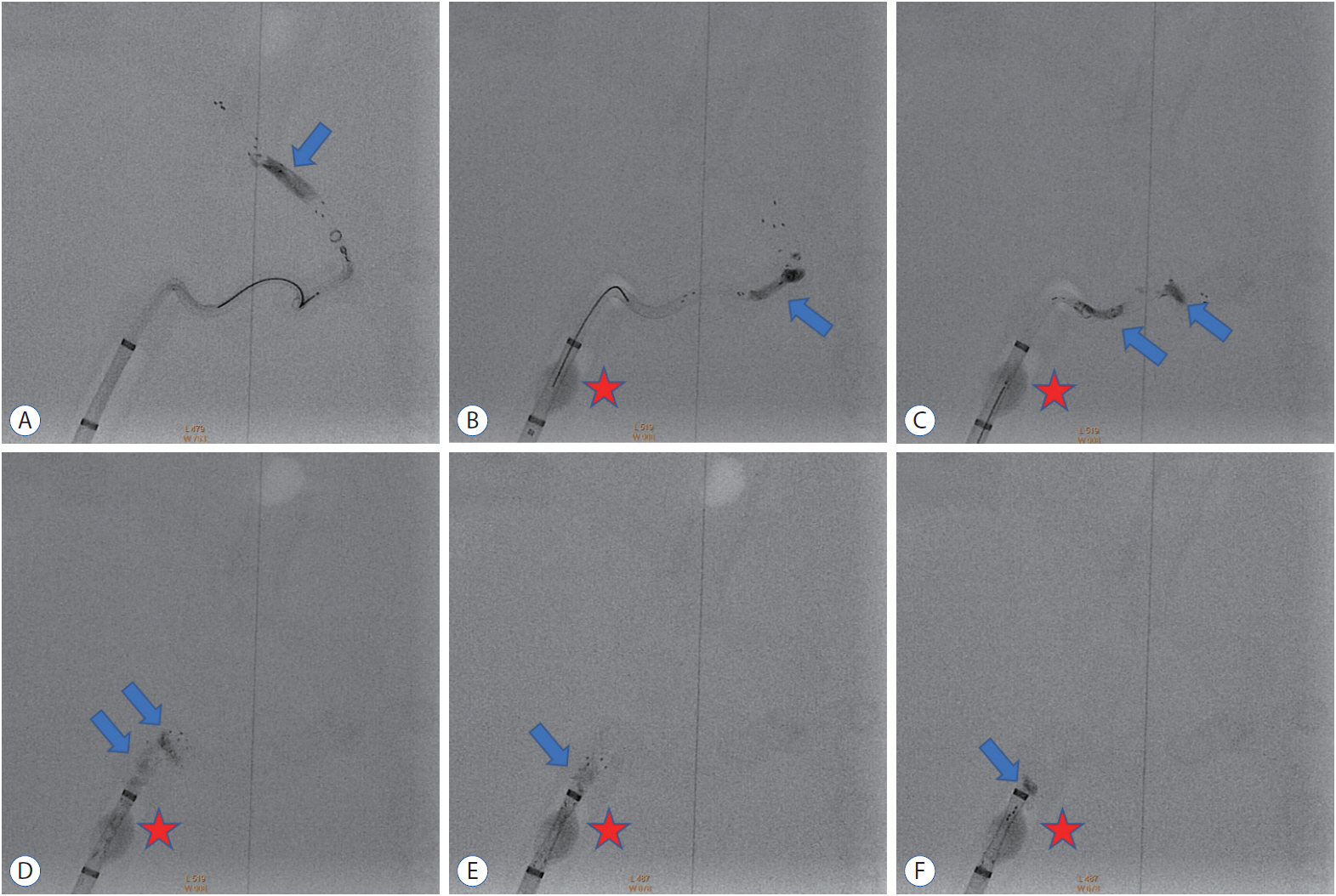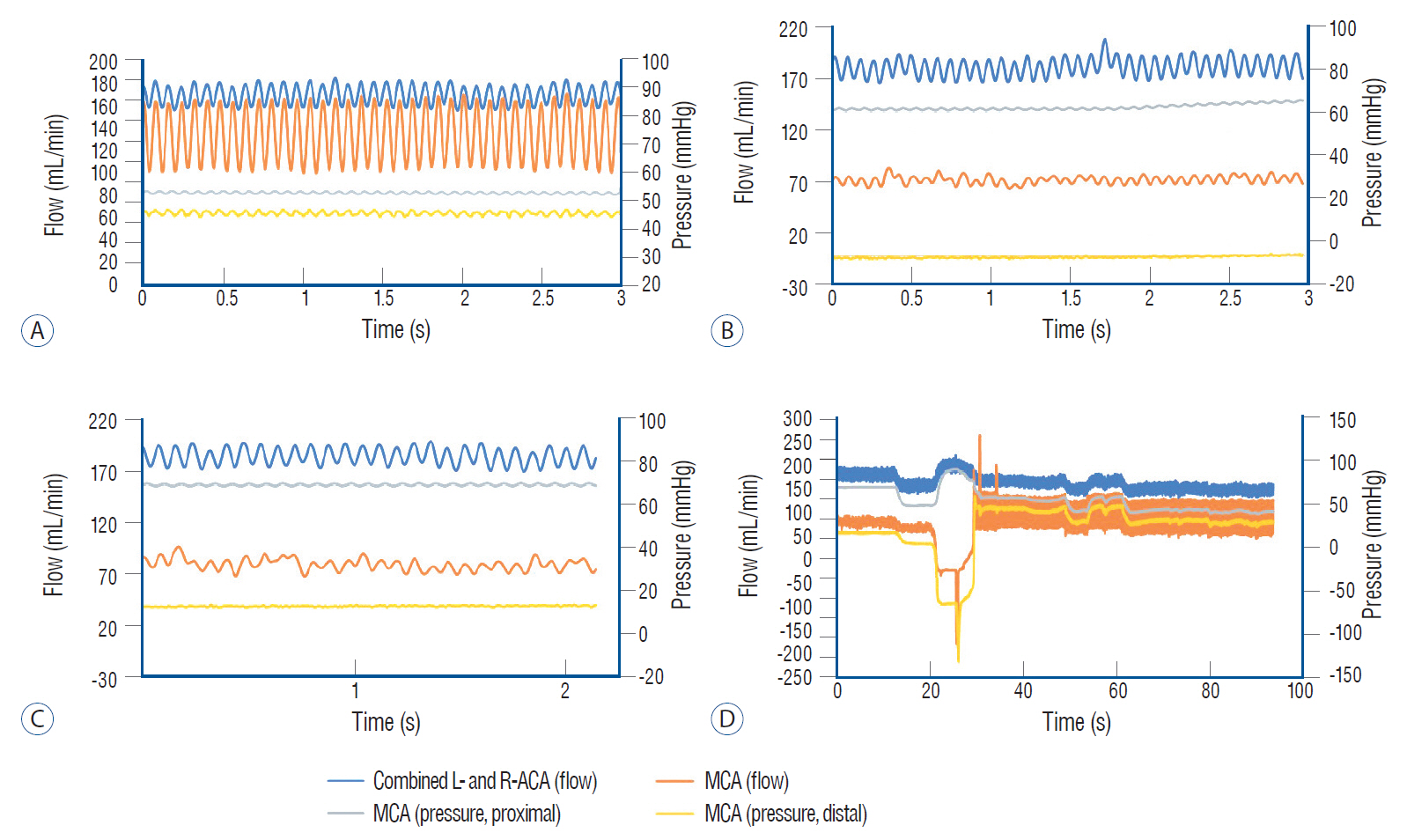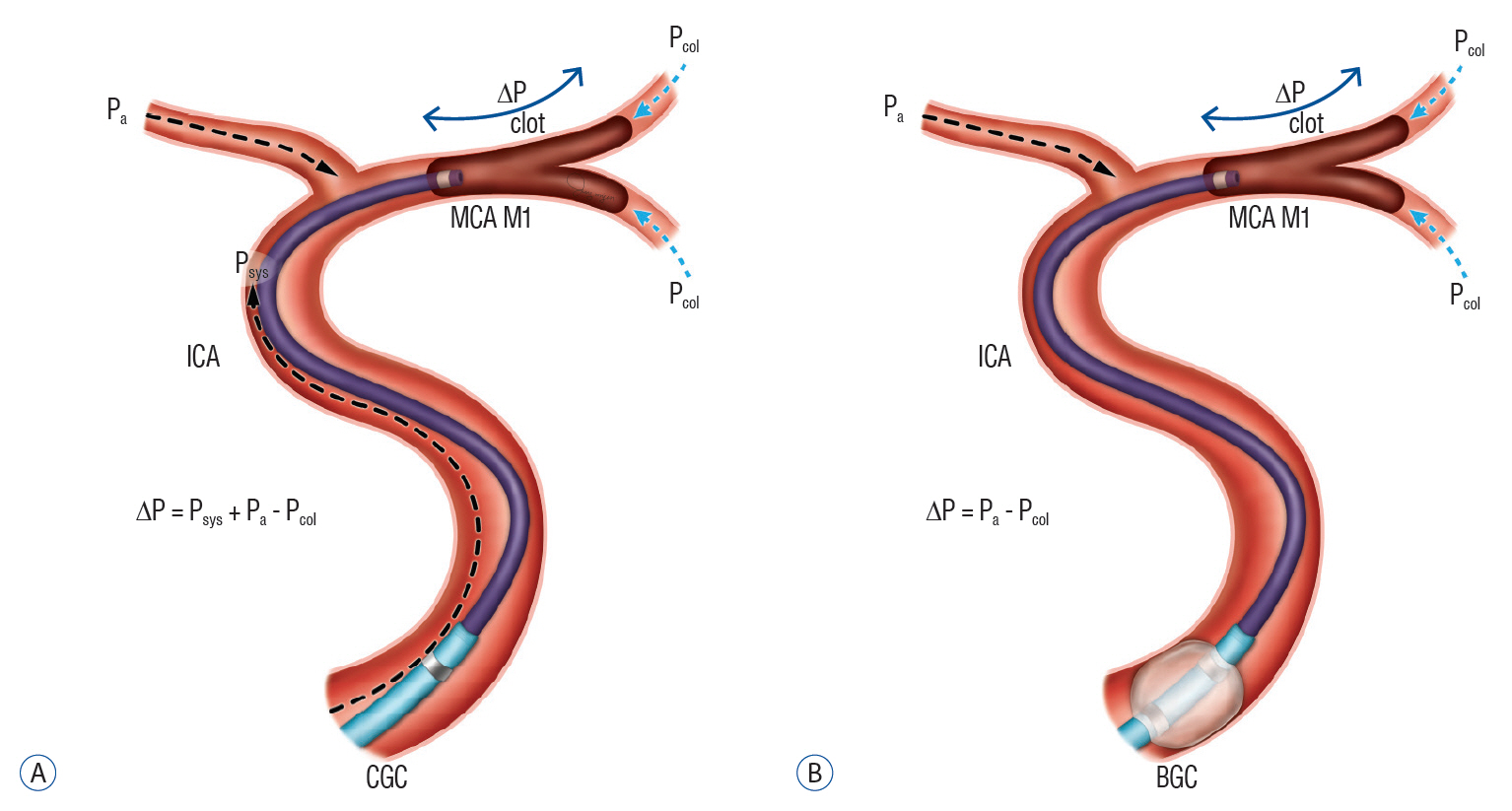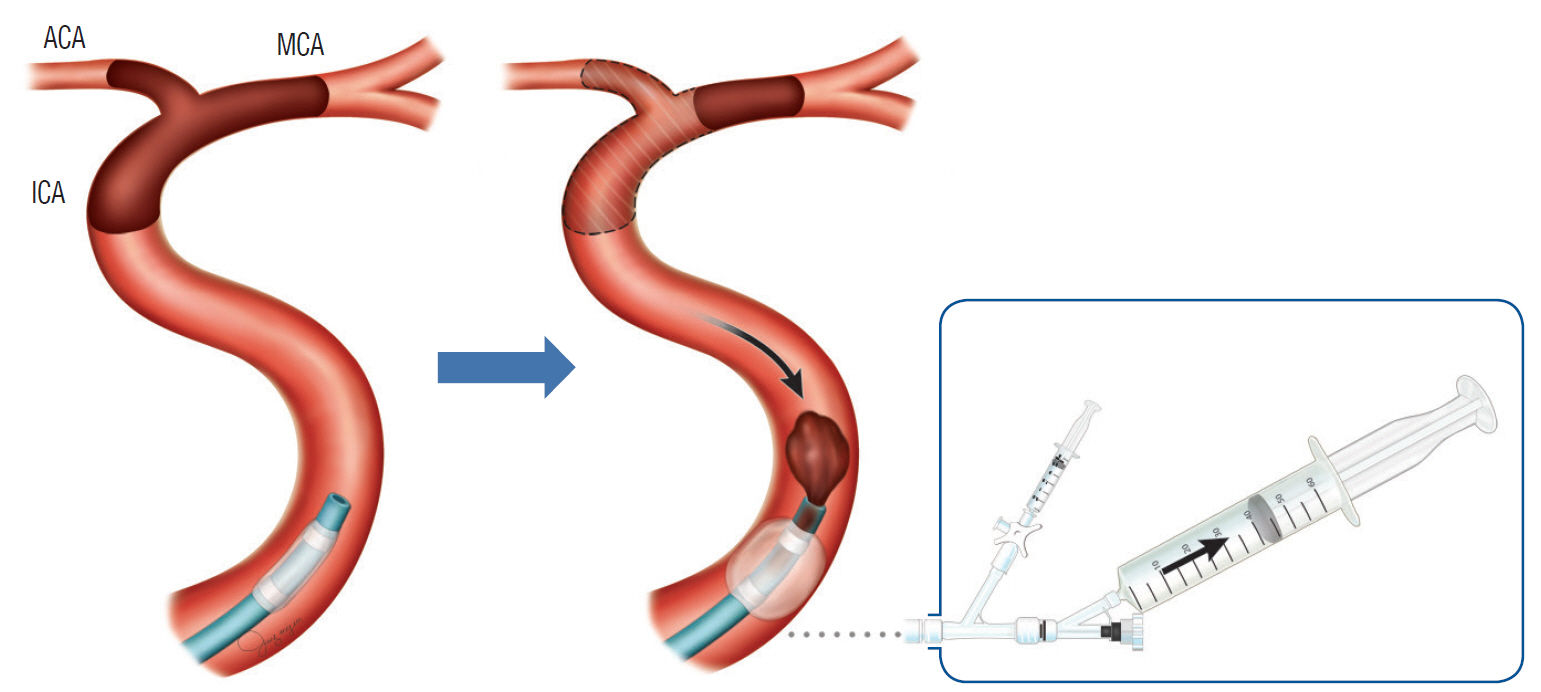J Korean Neurosurg Soc.
2020 Jan;63(1):14-25. 10.3340/jkns.2019.0114.
Role of Balloon Guide Catheter in Modern Endovascular Thrombectomy
- Affiliations
-
- 1Department of Radiology, New England Center for Stroke Research, University of Massachusetts Medical School, Worcester, MA, USA
- 2Department of Neurosurgery and Radiology, School of Medicine, Kyungpook National University, Daegu, Korea
- 3Department of Radiology, Severance Stroke Center, Severance Hospital, Yonsei University College of Medicine, Seoul, Korea
- KMID: 2501689
- DOI: http://doi.org/10.3340/jkns.2019.0114
Abstract
- Proximal flow control achieved with a balloon guide catheter (BGC) during endovascular treatment of acute ischemic stroke is reviewed in this article. In clinical practice, BGCs offer a multi-faceted approach for clot retrieval by creating proximal flow arrest, reducing embolic burden, and shortening procedure time. Evaluation of frontline thrombectomy procedures with BGCs revealed advantages of combined use over the conventional guide catheter (CGC), notably in the significant reduction of distal emboli to both the affected and previously unaffected territories. Recently, new measures of early and complete reperfusion at first thrombectomy pass have been identified as independent predictors of improved outcomes, which were consistently demonstrated with use of BGC as a safe and effective option to minimize number of passes during intervention. Prior randomized controlled trials reported the positive correlation between BGC-treated patients and a lower risk of mortality as well as shortened procedure time. While BGC use is more common in stent retriever-mediated mechanical thrombectomy, preliminary data has shown the potential benefit of device application during contact aspiration thrombectomy to achieve successful recanalization. However, the question of which major endovascular strategy reigns superior as a frontline remains to be answered. Along with clinical case assessments, BGC performance during in-vitro simulation was analyzed to further understand mechanisms for optimization of thrombectomy technique.
Figure
Cited by 2 articles
-
Can Transradial Mechanical Thrombectomy Be an Alternative in Case of Impossible Transfemoral Approach for Mechanical Thrombectomy? A Single Center's Experience
Hyun Wook Cho, Hyo Sub Jun
J Korean Neurosurg Soc. 2021;64(1):60-68. doi: 10.3340/jkns.2020.0240.Undeflatable balloon guide catheter (BGC) during endovascular procedure: Rescue strategy
Hyungkyu Lee, Taejoon Park, Jinwook Baek, Seonghwan Kim, Sangpyung Lee, Kyoungsoo Ryou
J Cerebrovasc Endovasc Neurosurg. 2022;24(4):372-379. doi: 10.7461/jcen.2022.E2021.10.005.
Reference
-
References
1. Ahn JH, Cho SS, Kim SE, Kim HC, Jeon JP. The effects of balloon-guide catheters on outcomes after mechanical thrombectomy in acute ischemic strokes : a meta-analysis. J Korean Neurosurg Soc. 62:389–397. 2019.
Article2. Berkhemer OA, Fransen PS, Beumer D, van den Berg LA, Lingsma HF, Yoo AJ, et al. A randomized trial of intraarterial treatment for acute ischemic stroke. N Engl J Med. 372:11–20. 2015.3. Brinjikji W, Starke RM, Murad MH, Fiorella D, Pereira VM, Goyal M, et al. Impact of balloon guide catheter on technical and clinical outcomes: a systematic review and meta-analysis. J Neurointerv Surg. 10:335–339. 2018.
Article4. Campbell BC, Mitchell PJ, Kleinig TJ, Dewey HM, Churilov L, Yassi N, et al. Endovascular therapy for ischemic stroke with perfusion-imaging selection. N Engl J Med. 372:1009–1018. 2015.
Article5. Chalumeau V, Blanc R, Redjem H, Ciccio G, Smajda S, Desilles JP, et al. Anterior cerebral artery embolism during thrombectomy increases disability and mortality. J Neurointerv Surg. 10:1057–1062. 2018.
Article6. Chueh JY, Kühn AL, Puri AS, Wilson SD, Wakhloo AK, Gounis MJ. Reduction in distal emboli with proximal flow control during mechanical thrombectomy: a quantitative in vitro study. Stroke. 44:1396–1401. 2013.
Article7. Chueh JY, Puri AS, Gounis MJ. An in vitro evaluation of distal emboli following lazarus cover-assisted stent retriever thrombectomy. J Neurointerv Surg. 9:183–187. 2017.
Article8. Chueh JY, Puri AS, Wakhloo AK, Gounis MJ. Risk of distal embolization with stent retriever thrombectomy and adapt. J Neurointerv Surg. 8:197–202. 2016.
Article9. Chueh JY, Wakhloo AK, Gounis MJ. Neurovascular modeling: smallbatch manufacturing of silicone vascular replicas. AJNR Am J Neuroradiol. 30:1159–1164. 2009.
Article10. Demerath T, Reinhard M, Elsheikh S, Keuler A, Urbach H, Meckel S. Balloon guide catheter in complex anterior circulation mechanical thrombectomy: beyond proximal occlusion and flow reversal. Clin Neuroradiol. 26:369–373. 2016.
Article11. Eesa M, Almekhlafi MA, Mitha AP, Wong JH, Goyal M. Manual aspiration thrombectomy through balloon-tipped guide catheter for rapid clot burden reduction in endovascular therapy for ICA L/T occlusion. Neuroradiology. 54:1261–1265. 2012.
Article12. Fargen KM, Arthur AS, Spiotta AM, Lena J, Chaudry I, Turner RD, et al. A survey of neurointerventionalists on thrombectomy practices for emergent large vessel occlusions. J Neurointerv Surg. 9:142–146. 2017.
Article13. Gascou G, Lobotesis K, Machi P, Maldonado I, Vendrell JF, Riquelme C, et al. Stent retrievers in acute ischemic stroke: complications and failures during the perioperative period. AJNR Am J Neuroradiol. 35:734–740. 2014.
Article14. Gilvarry M, Vale D. The role of in-vitro modeling in addressing challenging occlusions. J Neurointerv Surg. 8:A93. 2016.15. Goto S, Ohshima T, Ishikawa K, Yamamoto T, Shimato S, Nishizawa T, et al. A stent-retrieving into an aspiration catheter with proximal balloon (asap) technique: a technique of mechanical thrombectomy. World Neurosurg. 109:e468–e475. 2018.
Article16. Goyal M, Demchuk AM, Menon BK, Eesa M, Rempel JL, Thornton J, et al. Randomized assessment of rapid endovascular treatment of ischemic stroke. N Engl J Med. 372:1019–1030. 2015.
Article17. Gralla J, Schroth G, Remonda L, Nedeltchev K, Slotboom J, Brekenfeld C. Mechanical thrombectomy for acute ischemic stroke: thrombus-device interaction, efficiency, and complications in vivo. Stroke. 37:3019–3024. 2006.18. Haussen DC, Bouslama M, Grossberg JA, Nogueira RG. Remote aspiration thrombectomy in large vessel acute ischemic stroke. J Neurointerv Surg. 9:250–252. 2017.
Article19. Hong KS, Ko SB, Yu KH, Jung C, Park SQ, Kim BM, et al. Update of the Korean clinical practice guidelines for endovascular recanalization therapy in patients with acute ischemic stroke. J Stroke. 18:102–113. 2016.
Article20. Hougaard KD, Hjort N, Zeidler D, Sørensen L, Nørgaard A, Hansen TM, et al. Remote ischemic perconditioning as an adjunct therapy to thrombolysis in patients with acute ischemic stroke: a randomized trial. Stroke. 45:159–167. 2014.
Article21. Humphries W, Hoit D, Doss VT, Elijovich L, Frei D, Loy D, et al. Distal aspiration with retrievable stent assisted thrombectomy for the treatment of acute ischemic stroke. J Neurointerv Surg. 7:90–94. 2015.
Article22. Jovin TG, Chamorro A, Cobo E, de Miquel MA, Molina CA, Rovira A, et al. Thrombectomy within 8 hours after symptom onset in ischemic stroke. N Engl J Med. 372:2296–2306. 2015.
Article23. Kammerer S, du Mesnil de Rochemont R, Wagner M, You SJ, Tritt S, Mueller-Eschner M, et al. Efficacy of mechanical thrombectomy using stent retriever and balloon-guiding catheter. Cardiovasc Intervent Radiol. 41:699–705. 2018.
Article24. Kang DH, Hwang YH. Frontline contact aspiration treatment for emergent large vessel occlusion: a review focused on practical techniques. J Stroke. 21:10–22. 2019.
Article25. Kang DH, Kim BM, Heo JH, Nam HS, Kim YD, Hwang YH, et al. Effect of balloon guide catheter utilization on contact aspiration thrombectomy. J Neurosurg. 2018; [Epub ahead of print].
Article26. Kang DH, Kim JW, Kim BM, Heo JH, Nam HS, Kim YD, et al. Need for rescue treatment and its implication: stent retriever versus contact aspiration thrombectomy. J Neurointerv Surg. 2019; [Epub ahead of print].
Article27. Kang DH, Kim YW, Hwang YH, Park J, Hwang JH, Kim YS. Switching strategy for mechanical thrombectomy of acute large vessel occlusion in the anterior circulation. Stroke. 44:3577–3579. 2013.
Article28. Kang DH, Park J. Endovascular stroke therapy focused on stent retriever thrombectomy and direct clot aspiration: historical review and modern application. J Korean Neurosurg Soc. 60:335–347. 2017.
Article29. Kim BM. Causes and solutions of endovascular treatment failure. J Stroke. 19:131–142. 2017.
Article30. Kim YW, Kang DH, Hwang YH, Park J, Kim YS. Efficacy of proximal aspiration thrombectomy for using balloon-tipped guide catheter in acute intracranial internal carotid artery occlusion. J Korean Neurosurg Soc. 59:379–384. 2016.
Article31. Knox K, Kerber CW, Singel SA, Bailey MJ, Imbesi SG. Rapid prototyping to create vascular replicas from ct scan data: making tools to teach, rehearse, and choose treatment strategies. Catheter Cardiovasc Interv. 65:47–53. 2005.
Article32. Lapergue B, Blanc R, Gory B, Labreuche J, Duhamel A, Marnat G, et al. Effect of endovascular contact aspiration vs stent retriever on revascularization in patients with acute ischemic stroke and large vessel occlusion: the ASTER randomized clinical trial. JAMA. 318:443–452. 2017.
Article33. Lapergue B, Blanc R, Guedin P, Decroix JP, Labreuche J, Preda C, et al. A direct aspiration, first pass technique (ADAPT) versus stent retrievers for acute stroke therapy: an observational comparative study. AJNR Am J Neuroradiol. 37:1860–1865. 2016.
Article34. Lee DH, Sung JH, Kim SU, Yi HJ, Hong JT, Lee SW. Effective use of balloon guide catheters in reducing incidence of mechanical thrombectomy related distal embolization. Acta Neurochir (Wien). 159:1671–1677. 2017.
Article35. Liebeskind DS, Jahan R, Nogueira RG, Zaidat OO, Saver JL; SWIFT Investigators. Impact of collaterals on successful revascularization in solitaire fr with the intention for thrombectomy. Stroke. 45:2036–2040. 2014.
Article36. Maegerlein C, Berndt MT, Mönch S, Kreiser K, Boeckh-Behrens T, Lehm M, et al. Further development of combined techniques using stent retrievers, aspiration catheters and BGC : the PROTECTPLUStechnique. Clin Neuroradiol. 2018; [Epub ahead of print].37. Massari F, Henninger N, Lozano JD, Patel A, Kuhn AL, Howk M, et al. Arts (aspiration-retriever technique for stroke): initial clinical experience. Interv Neuroradiol. 22:325–332. 2016.
Article38. Maus V, Behme D, Kabbasch C, Borggrefe J, Tsogkas I, Nikoubashman O, et al. Maximizing first-pass complete reperfusion with save. Clin Neuroradiol. 28:327–338. 2018.
Article39. McTaggart RA, Tung EL, Yaghi S, Cutting SM, Hemendinger M, Gale HI, et al. Continuous aspiration prior to intracranial vascular embolectomy (CAPTIVE): a technique which improves outcomes. J Neurointerv Surg. 9:1154–1159. 2017.
Article40. Menon BK, Sajobi TT, Zhang Y, Rempel JL, Shuaib A, Thornton J, et al. Analysis of workflow and time to treatment on thrombectomy outcome in the endovascular treatment for small core and proximal occlusion ischemic stroke (ESCAPE) randomized, controlled trial. Circulation. 133:2279–2286. 2016.
Article41. Mokin M, Abou-Chebl A, Castonguay AC, Nogueira RG, English JD, Farid H, et al. Real-world stent retriever thrombectomy for acute ischemic stroke beyond 6 hours of onset: analysis of the nasa and track registries. J Neurointerv Surg. 11:334–337. 2019.
Article42. Mokin M, Ionita CN, Nagesh SV, Rudin S, Levy EI, Siddiqui AH. Primary stentriever versus combined stentriever plus aspiration thrombectomy approaches: in vitro stroke model comparison. J Neurointerv Surg. 7:453–457. 2015.
Article43. Mokin M, Setlur Nagesh SV, Ionita CN, Levy EI, Siddiqui AH. Comparison of modern stroke thrombectomy approaches using an in vitro cerebrovascular occlusion model. AJNR Am J Neuroradiol. 36:547–551. 2015.
Article44. Nguyen TN, Malisch T, Castonguay AC, Gupta R, Sun CH, Martin CO, et al. Balloon guide catheter improves revascularization and clinical outcomes with the solitaire device: analysis of the north american solitaire acute stroke registry. Stroke. 45:141–145. 2014.45. Nguyen TN, Malisch TW, Zaidat OO; North American Solitaire Acute Stroke Registry. Response to letter regarding article, “balloon guide catheter improves revascularization and clinical outcomes with the solitaire device: analysis of the north american solitaire acute stroke registry”. Stroke. 45:e86. 2014.
Article46. Nikoubashman O, Alt JP, Nikoubashman A, Büsen M, Heringer S, Brockmann C, et al. Optimizing endovascular stroke treatment: removing the microcatheter before clot retrieval with stent-retrievers increases aspiration flow. J Neurointerv Surg. 9:459–462. 2017.
Article47. Nikoubashman O, Wischer D, Hennemann HM, Sandmann J, Sichtermann T, Müschenich FS, et al. Balloon-guide catheters are needed for effective flow reversal during mechanical thrombectomy. AJNR Am J Neuroradiol. 39:2077–2081. 2018.
Article48. Oh JS, Yoon SM, Shim JJ, Doh JW, Bae HG, Lee KS. Efficacy of balloonguiding catheter for mechanical thrombectomy in patients with anterior circulation ischemic stroke. J Korean Neurosurg Soc. 60:155–164. 2017.
Article49. Okamura A, Kuroki K, Shinagawa K, Yamada N. Simple aspiration with balloon catheter technique (simple ABC technique) against proximal internal carotid artery occlusion in cases of cardiogenic cerebral embolism. Interv Neuroradiol. 24:317–321. 2018.
Article50. Pierot L, Soize S, Benaissa A, Wakhloo AK. Techniques for endovascular treatment of acute ischemic stroke: from intra-arterial fibrinolytics to stent-retrievers. Stroke. 46:909–914. 2015.
Article51. Powers WJ, Derdeyn CP, Biller J, Coffey CS, Hoh BL, Jauch EC, et al. 2015 American Heart Association/American Stroke Association focused update of the 2013 guidelines for the early management of patients with acute ischemic stroke regarding endovascular treatment: a guideline for healthcare professionals from the American Heart Association/American Stroke Association. Stroke. 46:3020–3035. 2015.
Article52. Saver JL, Goyal M, Bonafe A, Diener HC, Levy EI, Pereira VM, et al. Stent-retriever thrombectomy after intravenous t-PA vs. t-PA alone in stroke. N Engl J Med. 372:2285–2295. 2015.
Article53. Seong J, Sadasivan C, Onizuka M, Gounis MJ, Christian F, Miskolczi L, et al. Morphology of elastase-induced cerebral aneurysm model in rabbit and rapid prototyping of elastomeric transparent replicas. Biorheology. 42:345–361. 2005.54. Shah VA, Martin CO, Hawkins AM, Holloway WE, Junna S, Akhtar N. Groin complications in endovascular mechanical thrombectomy for acute ischemic stroke: a 10-year single center experience. J Neurointerv Surg. 8:568–570. 2016.
Article55. Simonsen CZ, Sørensen LH, Andersen G. Letter by simonsen et al Regarding article, “balloon guide catheter improves revascularization and clinical outcomes with the solitaire device: analysis of the north american solitaire acute stroke registry”. Stroke. 45:e85. 2014.
Article56. Smith WS, Furlan AJ. Brief history of endovascular acute ischemic stroke treatment. Stroke. 47:e23–e26. 2016.
Article57. Stampfl S, Pfaff J, Herweh C, Pham M, Schieber S, Ringleb PA, et al. Combined proximal balloon occlusion and distal aspiration: a new approach to prevent distal embolization during neurothrombectomy. J Neurointerv Surg. 9:346–351. 2017.
Article58. Stapleton CJ, Leslie-Mazwi TM, Torok CM, Hakimelahi R, Hirsch JA, Yoo AJ, et al. A direct aspiration first-pass technique vs stentriever thrombectomy in emergent large vessel intracranial occlusions. J Neurosurg. 128:567–574. 2018.
Article59. Teleb MS. Endovascular acute ischemic stroke treatment with flowgate balloon guide catheter: a single-center observational study of flowgate balloon guide catheter use. Interv Neurol. 7:327–333. 2018.
Article60. Turk AS, Frei D, Fiorella D, Mocco J, Baxter B, Siddiqui A, et al. ADAPT FAST study: a direct aspiration first pass technique for acute stroke thrombectomy. J Neurointerv Surg. 6:260–264. 2014.
Article61. Turk AS, Siddiqui A, Fifi JT, De Leacy RA, Fiorella DJ, Gu E, et al. Aspiration thrombectomy versus stent retriever thrombectomy as first-line approach for large vessel occlusion (COMPASS): a multicentre, randomised, open label, blinded outcome, non-inferiority trial. Lancet. 393:998–1008. 2019.
Article62. Turk AS, Spiotta A, Frei D, Mocco J, Baxter B, Fiorella D, et al. Initial clinical experience with the ADAPT technique: a direct aspiration first pass technique for stroke thrombectomy. J Neurointerv Surg. 6:231–237. 2014.
Article63. van der Marel K, Chueh JY, Brooks OW, King RM, Marosfoi MG, Langan ET, et al. Quantitative assessment of device-clot interaction for stent retriever thrombectomy. J Neurointerv Surg. 8:1278–1282. 2016.
Article64. Velasco A, Buerke B, Stracke CP, Berkemeyer S, Mosimann PJ, Schwindt W, et al. Comparison of a balloon guide catheter and a non-balloon guide catheter for mechanical thrombectomy. Radiology. 280:169–176. 2016.
Article65. Wahlgren N, Moreira T, Michel P, Steiner T, Jansen O, Cognard C, et al. Mechanical thrombectomy in acute ischemic stroke: consensus statement by ESO-Karolinska Stroke Update 2014/2015, supported by ESO, ESMINT, ESNR and EAN. Int J Stroke. 11:134–147. 2016.
Article66. Yoo AJ, Andersson T. Thrombectomy in acute ischemic stroke: challenges to procedural success. J Stroke. 19:121–130. 2017.
Article67. Zaidat OO, Castonguay AC, Linfante I, Gupta R, Martin CO, Holloway WE, et al. First pass effect: a new measure for stroke thrombectomy devices. Stroke. 49:660–666. 2018.68. Zaidat OO, Castonguay AC, Nogueira RG, Haussen DC, English JD, Satti SR, et al. Trevo stent-retriever mechanical thrombectomy for acute ischemic stroke secondary to large vessel occlusion registry. J Neurointerv Surg. 10:516–524. 2018.
Article69. Zaidat OO, Mueller-Kronast NH, Hassan AE, Haussen DC, Jadhav AP, Froehler MT, et al. Impact of balloon guide catheter use on clinical and angiographic outcomes in the stratis stroke thrombectomy registry. Stroke. 50:697–704. 2019.
- Full Text Links
- Actions
-
Cited
- CITED
-
- Close
- Share
- Similar articles
-
- Undeflatable balloon guide catheter (BGC) during endovascular procedure: Rescue strategy
- Clinical Experience with a Hybrid Procedure Using the Adherent Clot Catheter for Salvage of Thrombosed Hemodialysis Access: A Comparison with the Standard Fogarty Balloon Catheter
- Endograft Limb Occlusion after Endovascular Aneurysm Repair
- Effectiveness of Anchoring with Balloon Guide Catheter and Stent Retriever in Difficult Mechanical Thrombectomy for Large Vessel Occlusion
- Use of a Balloon Catheter for Occlusion of Iatrogenic Direct Carotid-Cavernous Fistula Occurring during a Neurointerventional Procedure





